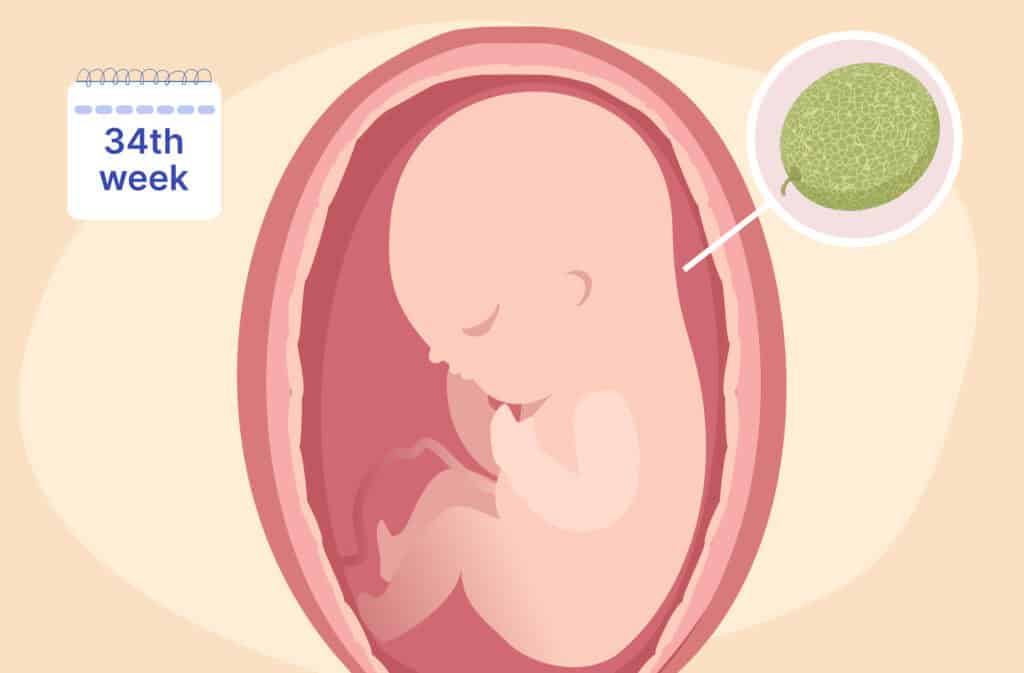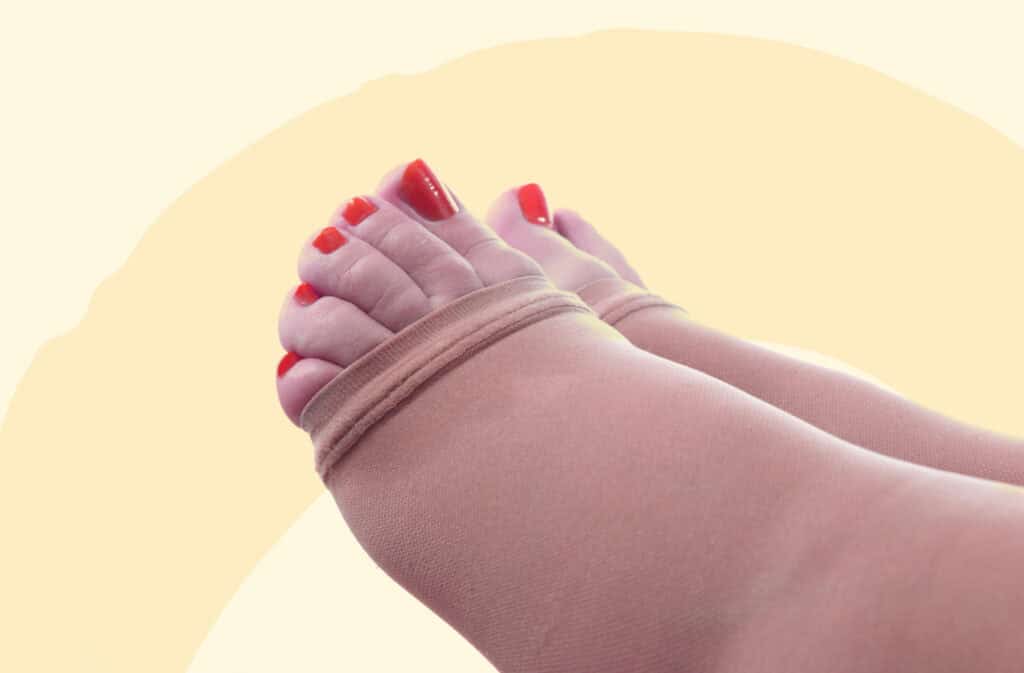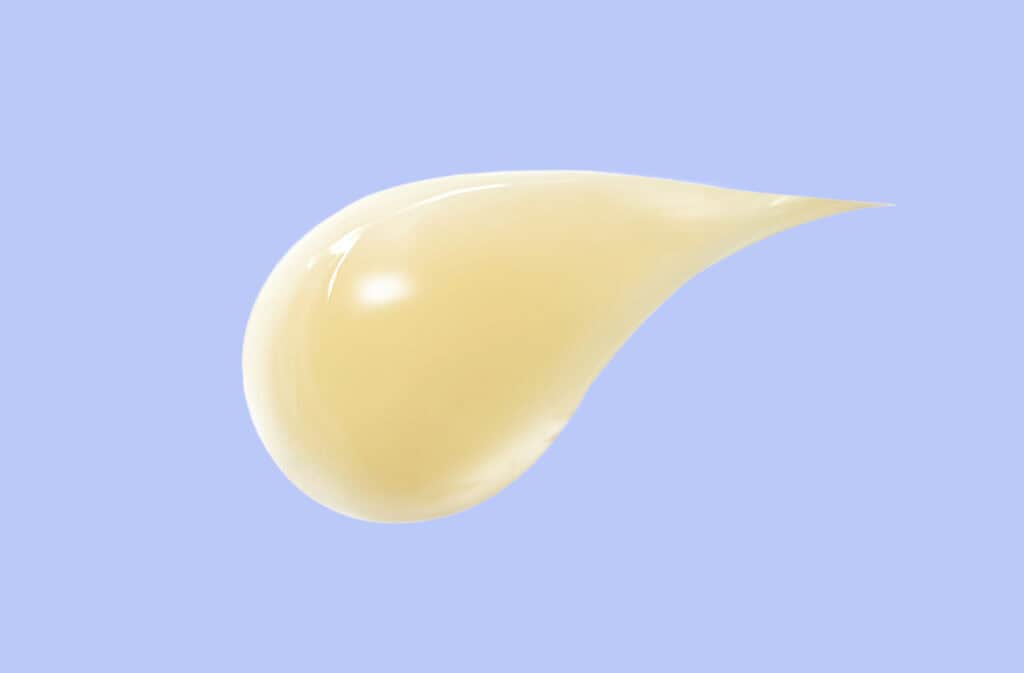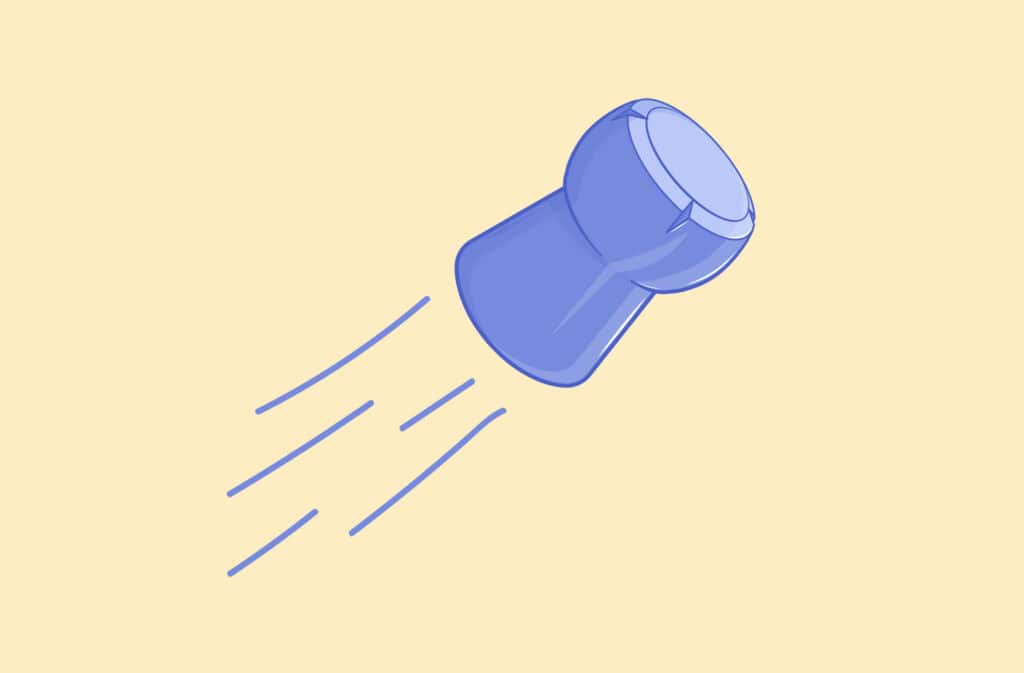Femia > Health Library > Pregnancy > Pregnancy week by week > 34 Weeks pregnant: Baby development, symptoms, and preterm labor signs
34 Weeks pregnant: Baby development, symptoms, and preterm labor signs

- Updated Feb 14, 2025
- Published
CRAFTED BY HUMAN
Crafted by human At Femia, we provide accurate and up-to-date information at every stage of your journey, from trying to conceive, pregnancy and postnatal support. All content is created by a real person based on in-depth research and own professional experience. Femia ensures that you will receive expert advice, strict accuracy and a personalized approach from our authors/medical experts. Learn more about our editorial policy.
FACT CHECKED
Fact checked At Femia Health, we maintain the highest standards of editorial excellence in delivering content focused on helping you conceive, guiding you through pregnancy, and supporting you postpartum. Explore our content review principles to learn how we ensure the accuracy and quality of our health and lifestyle tips for every stage of your journey.
At 34 weeks pregnant, your baby is nearing full-term readiness, while your body is preparing for labor. They weigh approximately 2.3 kilograms and measure about 18 inches, roughly the size of a cantaloupe. Watch for symptoms like cramping or preterm labor signs and focus on staying comfortable and prepared.
Welcome to week 34 of your pregnancy! At this stage, your baby is almost fully developed and practicing vital skills for life outside the womb. As your body prepares for delivery, you might notice new symptoms or a very active baby. Let’s dive into what’s happening with your baby, your body, and how to manage this exciting phase of week 34 of pregnancy.
Femia decodes your body’s signals and helps you track progress effortlessly
Pregnancy symptoms at 34 weeks
Here are the common symptoms you may experience at 34 weeks:
Aches and pains
At 34 weeks, it’s common to experience back pain, pelvic pain, and pressure on your joints. This is due to the added weight of your growing baby and the changes in your posture. The abdominal muscles that support your spine may weaken as your belly grows, contributing to discomfort. Pelvic girdle pain, stretching of ligaments, and sciatica can also add to the discomfort. It’s essential to rest, use supportive pillows, and consult with your healthcare provider if the pain becomes severe or persistent.
Constipation
Constipation is common during pregnancy, particularly in the later stages. The hormone progesterone relaxes the muscles in your digestive tract, slowing down food movement. This, combined with the pressure from your growing uterus, can make constipation worse. To manage it, drink plenty of water, eat fiber-rich foods, and stay active. If necessary, you can use stool softeners, but avoid laxatives.
Braxton Hicks contractions
These irregular contractions, also known as “practice contractions,” are common at 34 weeks. While they don’t cause cervical changes and aren’t a sign of labor, they may become more intense as you near delivery. They can be triggered by dehydration or fatigue, so staying hydrated and resting can help alleviate them. If contractions become more regular or painful, contact your healthcare provider to rule out preterm labor.
Fatigue
Fatigue often returns by the 34th week, though it might not be as intense as in the first trimester. Your body is working hard, and sleep may become harder due to physical discomfort and frequent bathroom trips. If you’re struggling to stay alert, talk to your provider to rule out conditions like iron-deficiency anemia or depression.
Vaginal discharge
It’s normal to have more vaginal discharge during pregnancy, which can be clear, white, or slightly yellowish. If the discharge changes color, becomes smelly or is accompanied by itching or pain, consult your healthcare provider as it could indicate an infection. If you notice a thick, mucus-like discharge or a mucus plug, it could be a sign your body is preparing for labor.
Leaking breasts
At 34 weeks, your body is preparing to feed your baby. This might cause colostrum, the first form of breast milk, to leak from your breasts. It’s normal, and you don’t need to do anything about it unless it’s bothersome. You can use nursing pads to absorb the fluid if necessary.
34 Weeks pregnant pelvic pain
Pelvic pain at 34 weeks is common as your body prepares for childbirth. The growing weight of your baby puts pressure on your pelvis and lower back, which can lead to discomfort. The softening of ligaments and joints in preparation for delivery can also contribute to pelvic pain. This discomfort might be sharp or dull and could feel like pressure in the pelvic area or groin. Rest, pelvic support belts, and gentle stretches can help alleviate some of the pain. If the pain is severe or persistent, contact your healthcare provider for further guidance.
Braxton Hicks contractions vs true labor
| Aspect | Braxton Hicks Contractions | True Labor |
|---|---|---|
| Frequency | Irregular, not progressively closer together | Regular intervals, getting closer together |
| Intensity | Weak, often described as mild discomfort | Increases in strength over time |
| Duration | Short, usually lasting less than 30 seconds | Longer, lasting 30-70 seconds per contraction |
| Location of Pain | Felt mainly in the front of the abdomen | Starts in the back and radiates to the front |
| Effect of Movement | Stops or decreases with activity or a change in position | Continues regardless of movement or position changes |
| Cervical Changes | Does not cause dilation or thinning of the cervix | Causes the cervix to dilate and thin out (effacement) |
34 Weeks pregnant symptoms not to ignore
Cramping
While mild cramping is normal as your body adjusts during pregnancy, persistent or painful cramps at 34 weeks can be a sign of preterm labor. If the cramps are accompanied by lower back pain or a change in vaginal discharge, this could indicate the onset of labor. If the cramping doesn’t subside with rest or hydration, it’s important to contact your healthcare provider immediately. Early intervention can help assess whether labor is starting prematurely.
Regular, painful contractions
If you experience regular contractions that occur at consistent intervals and increase in intensity, this may signal the onset of labor. In the final weeks of pregnancy, it’s normal to experience Braxton Hicks contractions, but if they become more frequent, painful, or last longer, it could be a sign of preterm labor. If contractions are happening every 10 minutes or more frequently, it’s essential to seek medical attention right away to ensure both your safety and your baby’s well-being.
Severe swelling
Swelling is a common symptom in the third trimester, but severe swelling, especially in the face, hands, or feet, may be a sign of preeclampsia, a serious pregnancy complication. Preeclampsia is associated with high blood pressure and can affect your organs, so it’s crucial to seek medical advice if you notice rapid or excessive swelling. Your doctor may perform tests to evaluate your blood pressure and overall health to ensure that preeclampsia is not developing.
Reduced baby movements
A noticeable decrease in your baby’s movements at 34 weeks is a cause for concern. Babies typically have regular movement patterns, and any significant reduction in activity could signal potential complications such as fetal distress or other pregnancy issues. While babies may have quieter periods, it’s important to contact your healthcare provider immediately if you notice a dramatic decrease in movement, as early intervention can ensure your baby’s health and prompt proper care.
Your body at 34 weeks pregnant
At 34 weeks pregnant, your body is continuing to adapt to the rapid growth and changes occurring as your baby prepares for birth. You might also experience more frequent Braxton Hicks contractions as your body practices for labor.
During this stage, your body is also undergoing hormonal changes, which help soften the cervix and prepare your body for the upcoming birth. It’s not uncommon for women to feel increasingly fatigued as the third trimester progresses, as your body is working hard to support your growing baby. While the physical strain can feel overwhelming at times, staying hydrated, using pillows for extra support, and practicing relaxation techniques can help alleviate discomfort and make you feel more comfortable as you approach the final weeks of your pregnancy.
34 Weeks pregnant in months
You are approximately 8.5 months pregnant, with just six weeks left until your due date.
34-Week pregnant belly
Your growing bump is more prominent, and the added weight can put pressure on your joints, especially your pelvis and lower back. As your baby moves lower into the pelvis in preparation for delivery, you may begin to feel more pressure in that area, along with increased discomfort in your lower back and hips. Your belly is likely heavier and more round. Some women notice itching or tightness as their skin stretches—moisturizers can help ease this discomfort.
Baby development at 34 weeks pregnant
At 34 weeks pregnant, your baby’s development is progressing rapidly, with significant growth and maturation happening in their brain, lungs, and other vital organs. The baby’s lungs are continuing to mature, and they are practicing essential skills such as breathing, sucking, and swallowing. These actions are critical for survival once they’re born. Additionally, your baby is gaining fat beneath their skin, which will help regulate their body temperature after birth and give them a rounder, more newborn-like appearance.
Baby at 34 weeks
- Weight: Approximately 2.3 kilograms (5 pounds).
- Length: Around 18 inches, a fetus is about the size of a cantaloupe.
- Movements: You may feel your baby moving more deliberately, with noticeable stretches, kicks, and rolls as they adjust to their limited space. These movements are becoming stronger and more coordinated as your baby continues to grow and develop.
- Growth and development: Your baby’s brain is rapidly developing, and they are now able to regulate body functions more effectively. The fat stores they’re accumulating under the skin will help them maintain body temperature once they’re born. Their bones are becoming denser, and they’re practicing breathing movements to prepare for life outside the womb.
34-Week ultrasound
A 34-week ultrasound may be recommended if your provider needs to check growth, amniotic fluid levels, or your baby’s position. You might see your baby’s facial expressions and more refined movements during this scan.
34-Week preemie: What to expect
A baby born at 34 weeks is considered late preterm and typically has a survival rate of over 99% with proper medical care.
Development and care:
- Lungs: Usually developed enough for independent breathing but may need support.
- Feeding: Some babies may require assistance until their sucking reflex fully matures.
- NICU support: Care may include monitoring for temperature regulation and potential jaundice.
Most babies born at 34 weeks thrive with minimal intervention and catch up developmentally with their peers within a few months.
Femia decodes your body’s signals and helps you track progress effortlessly
Tests to expect at 34 weeks pregnant
Routine tests help monitor your health and your baby’s progress:
- Blood pressure check: Screens for preeclampsia or hypertension.
- Fetal heartbeat and movements: Your provider will listen to your baby’s heartbeat and ask about their activity.
- Urine test: Checks for protein and glucose, which can indicate preeclampsia or gestational diabetes.
- Fundal height measurement: Ensures your uterus is growing appropriately.
- Group B strep (GBS) test: This test may be done between 34-36 weeks to check for GBS bacteria, which could affect delivery.
👉Find out more:
Week 35 pregnancy: Symptoms, baby milestones, and delivery prep
36 Weeks pregnant: Baby weight, discomfort relief, and delivery prep
Health tips and self-care at 34 weeks pregnant
Rest frequently
As you approach the final stretch of your pregnancy, it’s important to listen to your body and take breaks when needed. Resting frequently helps your body recover and reduces fatigue. Make sure you’re getting enough sleep at night, and take naps during the day when you can. Prop yourself up with pillows to help with comfort while you sleep.
Track baby movements
Monitoring your baby’s movements is crucial at this stage. While it’s normal for your baby to move less as they run out of space, it’s important to pay attention to any noticeable changes in activity. If you notice that your baby is moving less or you experience a significant reduction in movements, reach out to your healthcare provider immediately. Keeping track of baby movements is a simple way to ensure their well-being.
Stay hydrated
Drinking plenty of water is essential for maintaining hydration, which supports both your circulation and the reduction of swelling. Increased fluid intake also helps prevent urinary tract infections (UTIs) and supports amniotic fluid levels. Aim to drink at least 8-10 glasses of water a day, or more if you’re active.
Prepare for labor
Now is the time to familiarize yourself with the signs of labor, such as regular contractions or changes in vaginal discharge. Practice relaxation techniques, including deep breathing exercises, to help manage stress and prepare for the pain of labor. Consider attending prenatal classes or having a discussion with your healthcare provider about what to expect during labor and delivery.
Consider maternity leave
By this point in your pregnancy, it’s a good idea to start planning for your maternity leave. Check with your employer about the policies regarding paid and unpaid leave. This will give you time to mentally prepare for your baby’s arrival and ensure that you have everything set up for when you’re ready to take time off from work. Plan ahead to make the transition as smooth as possible.
Questions from the Femia community
How far apart should contractions be?
Early labor contractions are typically 15-20 minutes apart and become progressively closer, around 5 minutes apart, as labor intensifies. Active labor contractions are consistent, lasting 45-60 seconds each. If your contractions are regular and 5 minutes apart or less, contact your healthcare provider or head to the hospital.
What questions should I ask my partner before giving birth?
Discuss their role during labor: Will they provide physical support, such as back massages, or focus on emotional reassurance? Clarify their comfort level with medical procedures, like cutting the umbilical cord or being in the delivery room. Also, plan post-birth responsibilities, such as nighttime care, diaper changes, and feeding support, to ensure clear communication and teamwork.
What to avoid at 34 weeks pregnant?
At 34 weeks pregnant, avoid excessive physical strain, high-stress situations, and lifting heavy objects. Be cautious of standing or sitting for long periods, as this can increase swelling and discomfort. Also, avoid overheating, as your body may have difficulty regulating temperature.
Is it normal for a baby to be super active at 34 weeks?
Yes, it’s normal for your baby to be very active at 34 weeks. Your baby may move around more, and you may feel stronger kicks, rolls, and stretches as they grow and run out of space in the uterus.
Does a very active baby mean labor is near?
Not necessarily. A very active baby does not indicate that labor is imminent. Babies can have periods of increased movement throughout pregnancy. However, if you notice a significant decrease in movement, it’s important to contact your healthcare provider.
The bottom line
At 34 weeks pregnant, your baby is nearing full-term readiness, and your body is preparing for delivery. Monitor symptoms, discuss birthing plans with your partner, and familiarize yourself with labor signs to feel confident and prepared as you approach the final weeks.
References
- “34 Weeks Pregnant: Symptoms, Baby Development & Tips.” BabyCenter, www.babycenter.com/pregnancy/week-by-week/34-weeks-pregnant.
- “Week 34 of Pregnancy: Symptoms, Baby Development & More.” What to Expect, www.whattoexpect.com/pregnancy/week-by-week/week-34.aspx.
- “34 Weeks Pregnant: Baby Development, Symptoms & Tips.” NHS, www.nhs.uk/pregnancy/week-by-week/1-to-12/34-weeks/.
- “Pregnancy Week 34: What to Expect.” American Pregnancy Association, www.americanpregnancy.org/healthy-pregnancy/week-by-week/34-weeks-pregnant/.

Learn what’s normal, how to reduce swelling, and when to seek urgent medical care for serious conditions like preeclampsia or blood clots.

Yellow discharge is generally nothing to worry about. However, it can be a sign of infection if accompanied by symptoms such as an unpleasant odor and itching.

Discover things to avoid after losing mucus plug and what to do next. Learn how long after losing mucus plug labor starts and what happens to your body. Expert advice from Femia.

